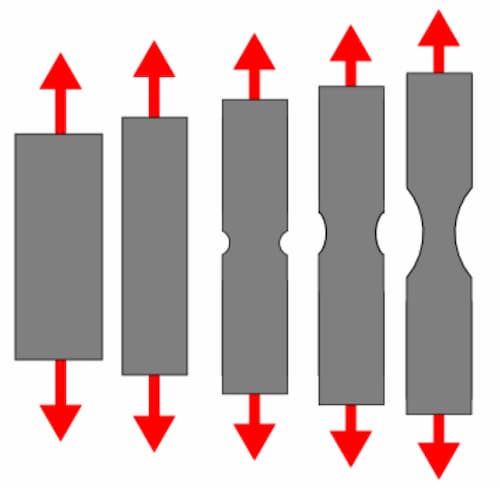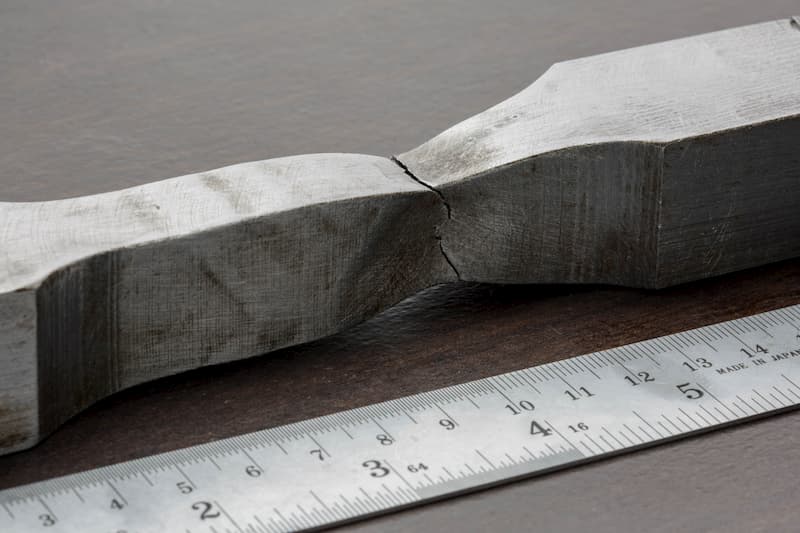Ultimate tensile strength (or just tensile strength for short) is an important property of materials to determine their mechanical performance. It is the ability of a material to resist tearing due to tension. This parameter applies to all types of materials such as wires, ropes, metal beams, etc.
What Is Tensile Strength?
Imagine a strip of paper being pulled at its two ends with your fingers. You are applying a tensile force on the strip. When this tensile force crosses a certain threshold, the paper tears. The tensile stress at which this takes place is the tensile strength of that material, in this case paper.
When excessive tension is applied, both ductile, as well as brittle materials will approach a point of failure. Initially there will be a uniform deformation observed. All throughout the body of the material, its length will increase while its width reduces at the same rate.
Ultimate tensile strength is the amount of stress that pushes materials from the state of uniform plastic deformation to local concentrated deformation. The necking phenomenon begins at this point.

Ultimate tensile strength is an intensive property. In other words, it does not depend on the size of the sample. The same material with varying cross-sectional area will have the same value of tensile strength.
As this type of fracture in a system can cause failure and possibly endanger life, it is imperative that this parameter is considered while selecting appropriate materials for an application.
Ultimate Tensile Strength on a Stress-Strain Curve
There are 4 major regions that a stress-strain curve can be divided into:
- Proportional limit
- Yield limit
- Strain hardening
- Necking
Proportional Limit
In the proportional limit, the specimen material acts like a spring and any strain caused is completely reversible. On the stress-strain curve, this area is called the Hooke’s region. The reason lies with the applicability of Hooke’s Law for forces that fall into the area.
Yield Limit
As soon as the specimen passes the proportional limit, it enters the yield limit region. At this point, permanent deformation sets in. From this point on, it doesn’t matter if you release the tensile force or apply a force in the opposite direction, the specimen will not return to its original dimensions.
Strain Hardening Region
On further increasing the tensile stress, the specimen enters the strain hardening region. This is a very unique section because you are changing the crystal structure of the material. The material is under enough stress that its very microstructure is modified.
As the name suggests, the material becomes harder and tougher. This hardening can be very useful and so it is not necessarily a bad thing (cold hardening, cold forming processes actually use this region to impart strength to the workpiece).
Necking Region
Right before entering the necking phase, the material is the strongest it will ever be. We have strain hardened it to its maximum limit. When we enter the necking phase, the material starts to get weaker. It is characterized by a local reduction in cross-section.
Beyond this point, the material is only moving towards failure. It can handle less stress with increasing strain.
We can sort of go back to the original equation that says stress is equal to force per unit area and infer that the smaller the area, the higher the stress. The material moves beyond this point until rupturing.
Ultimate Tensile Strength on the Curve
The point that separates the strain hardening region and the necking region is the ultimate strength for that material. At this point, the maximum amount of strain hardening has taken place. The material is handling the highest amount of load it can handle safely.
Ultimate strength is, therefore, a crucial point to be considered on the stress-strain curve. It shows the maximum amount of stress a material can bear before failure.
- Personal account manager
- Quality assurance
- Payment terms for companies
- On-time delivery by Fractory
Why Is Tensile Strength Important?
It is imperative to know the tensile strength of a particular metal or any material to ensure it is the right choice for an application. This ensures an incident-free service life.
The results of choosing materials with lower tensile strength than what the application demands can be disastrous.
Engineers turn to yield strength in the design phase to make sure the stress never reaches any higher than that. Otherwise, the structure suffers permanent deformations. But ultimate tensile strength tells us the value that is necessary for complete failure and breaking.
Thus, a roof construction that comes under more stress because of a higher than normal snow load may bend the structure. At the same time, surpassing the tensile strength value means that the roof may fall in.
Tensile Strength vs Yield Strength
Engineers use yield strength when designing products. Keeping the load within this area ensures the product is safe from failure. This means that the maximum load has to stay below the yield strength limit at all times.
A common way of doing so is by determining the maximum load first. Taking the specifics of the chosen material into account, calculations give the answer for the necessary cross-sectional area. Geometry plays an important role in how high loads a part can withstand.
As an extra precautionary measure, a safety factor is added. The safety factor usually falls somewhere between 1.5 and 2. The simplest way of using it is just multiplying the maximum load value by the factor. Adding the safety factor ensures that unexpected loads and material imperfections will not result in broken parts.
Designing for ultimate tensile strength means your part will permanently deform once subjected to the load it was designed for. The material’s crystal structure may change and it will probably lose an important property. This means that the product no longer has the same characteristics that may have been the very reason for its selection.
An important point to note here is that some tools like knives and spanners are strain hardened so that they can be stronger and closer to their ultimate tensile strength value before they can potentially fracture.
Tensile Testing
Tensile strength is measured by elongating a specimen in a Universal Testing Machine (UTM). A UTM is a tensile testing machine.
The specimen is held on opposite ends using clamps. One of the ends is stationary while pulling the other with real-time monitoring of the forces. A steady increase of force takes place until reaching a point where the specimen breaks. The recording of tensile test data is constant all through the process.
This tensile tester consists of features such as servo automation control (electro-hydraulic), data acquisition, automatic measurement, screen display and test result calculation.
The maximum force that was applied is then divided by the cross-sectional area to obtain the maximum stress it was subjected to. This maximum stress is the value of ultimate tensile strength.
The SI unit of ultimate tensile strength is N/m2 or Pascal with large numbers being expressed in megapascals.
Examples for Material Tensile Strength
The tensile strength of materials varies significantly. Mechanical engineers use mostly metals because they offer a good return for value and other great properties besides relatively high tensile strength. But it is evident that the range within different types of metals alone is huge.
At the same time, we can see that non-metals like carbon fibers far exceed metals in terms of ultimate tensile strength values. Even human hair can take half the load of structural steels before eventually breaking.
So whether it is a 5th-grade boy who wants to know how hard he can pull a girl’s ponytail before getting attention turns into making her bald, or an engineer who needs to know how much the elevator cable can actually take before breaking, the answer lies here – with ultimate tensile strength.






